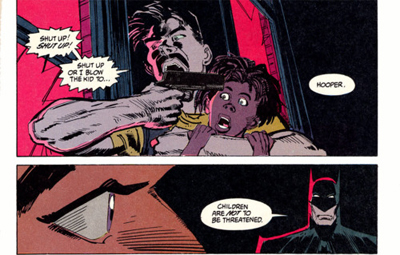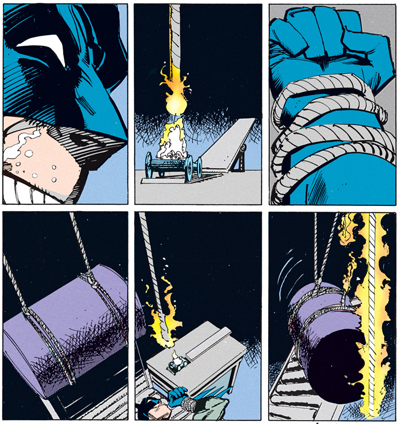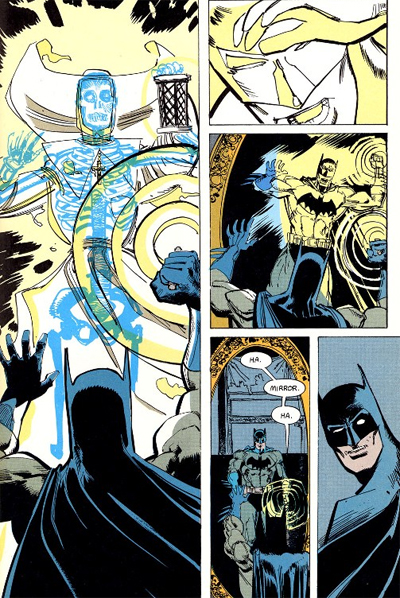Legends of the Dark Knight was an interesting concept – tell self-contained stories using different creative teams set at various points during Batman’s crime-fighting career. As such, those stories would make the title easy to pick up, without tying it excessively to continuity. It’s a simple and an interesting premise, and it did produce all manner of intriguing Batman stories. Grant Morrison’s Gothicis perhaps one of the most intriguing of those stories, taking the character well outside what readers might have expected.
Grant Morrison’s five-issue story arc sits awkwardly between his first Batman work (Arkham Asylum: A Serious House on a Serious Earth) and his later extended on tenure on the character, writing Batman, Batman & Robin and Batman Incorporated, among other books. While the storyline is, understandably, relatively short and self-contained, it does do an excellent job encapsulating some of the themes that Morrison would explore and develop during his time on the character.
Indeed, the villain of the piece seems quite familiar. Mr. Whisper is a man who sold his soul to the devil in order to live a life devoted to sin and corruption. He seems relatively similar in form and archetype to the sinister Dr. Hurt, right down to the connection to Bruce’s past and the heavy use of occult imagery. The very first panel of Gothic features Gotham City laid out like a sequence of overlapping crosses as roads and train lines overlap to form a “sacred geometry”of the city. Like Hurt, Whisper plans to hold some sort of occult ritual while unleashing a plague upon Gotham.
Of course, such antagonists lend themselves to Morrison’s Batman. The writer has stated in interviews that he’s not really too interested in what he considers to be a conventional Batman story – the character fighting the same adversaries once again, defeating them the same way. With the absence of the Joker, Morrison hasn’t really dealt with too many of the familiar Batman villains outside of Arkham Asylum. Instead, Morrison likes to challenge Batman by pitting the character against foes well outside his weight class, and outside his frame of reference. “I feel as though I’m trying to do a jigsaw puzzle in the dark,” Batman remarks as he tries to make sense of his dreams, and there’s a sense that Morrison thinks that’s the only way to really make a jigsaw challenging for Batman.
On one hand, the way the story embraces the macabre and the supernatural seems at odds wit the conventional structuring of Batman’s world. Yes, he is close friends with a magician and has been know to deal with demons, but he very rarely finds himself facing immortal opponents who struck deals with the devil. More importantly, Batman stories are rarely told in this style, the style of gothic horror. Admittedly by featuring the gangs of Gotham, Morrison does pay heed to the pulpy noir-ish roots of the character, but it’s the creepy occult imagery that dominates with symbols like the inverted bat-signal and the recurring figure eight – the infinity symbol rotated ninety degrees, if not quite inverted.
And, yet, Morrison seems to have a great deal of fun placing this adventure within the context of Frank Miller’s Year One. After all, these Legends of the Dark Knight stories were (at least originally) supposed to unfold early in the Caped Crusader’s career. So, as one might imagine, Morrison has a bit of fun at the expense of Miller’s take on Batman, revelling in writing the sort of melodramatic hard-ass Miller so enjoyed portraying. Morrison introduces Batman proclaiming, “Gotham City is Hell. We are all in Hell. And I am the king of Hell!” It seems that the Scottish writer takes great pleasure in channelling Miller’s depiction of “hell on earth” to a more literal form of Hell.
Throughout the script, in dealing with the mob – who exist purely to get slaughtered – Batman is as anti-social as Miller ever wrote him. “You and your kind have turned Gotham City into a Hell,” he warns the crooks who dare to come to him for protection. “Now rot in it.”There’s nothing more terrifying than the sight of Miller’s frequent collaborator Klaus Janson illustrating Batman’s deliciously evil grun as he scares the life out of some poor Gotham lowlife.
And yet Morrison is careful to offset this, as if to undermine the grave seriousness with which Miller treated the Dark Knight. As one might expect from reading his recent run on the title, Morrison eschews gritty realism for a chance to play with Batman’s toys, like an improbably small breathing apparatus or the bat-plane. Bruce’s methods of deducing the source of his adversary are hardly rational, as he follows a tape recording of his father that he filed incorrectly. “Is that not something of a tenuous clue, Master Bruce?” Alfred asks. Of course, it turns out to be correct.
At one point the villain has Batman in his hands, but doesn’t kill him outright. He’s careful to have the bad guy outline his history, motivations and his goal, even conceding, “I don’t know why I’m telling you this.” Naturally, rather than killing Bruce, he traps him inside an elaborate death trap. “As you can see, I’ve gone to some trouble to prepare a suitably elaborate death for you,” Whisper explains. “When this candle burns down, it will set in motion a chain reaction. I won’t go into all the details, but it all ends with that very large oil drum crushing your fragile skull.”
These are, of course, the narrative conventions of comic books, but they’d been largely eschewed towards the end of the eighties and into the nineties, in the wake of books like Watchmen and The Dark Knight Returns. Morrison, of course, clearly has a strong sense of nostalgia for these old storytelling tools, and hits every note like a professional. Indeed, he even makes sure that Batman does a bit of globe-trotting on this adventure, foreshadowing the direction he’d eventually take the character.
At one point Bruce explains gothic architecture of a cathedral and – in a way – the story is constructed using that architecture. The villain is a monster. There’s no ambiguity such as clouds Matt Wagner’s Batman and the Mad Monk. To combat him, Batman is driven not by logic and rationality, but by dreams and feelings and coincidences. These are structured to manoeuvre him to where he needs to be, just like the cathedral is so structured as to manoeuvre the souls to where Mr. Whisper needs them to be.
Yes, Morrison plays with character’s personality and his back story. It’s a trick he’d employ in Batman R.I.P. as well. In a way, it feels like a conscious shout out to all those “secret history” stories from the Golden of Silver Ages, where we’d discover some strange incident from the character’s past. (Like the idea that Bruce and Clark used to hang out together, or that sort of thing.) We never knew that Bruce went to a boarding school and we certainly never knew that his parents were killed on the day he came home before his father could expose the killer.
We’re assured that Mr. Whisper had nothing to do with the death of the Waynes that night (he assures Bruce it was “blind fate”), but I’ll admit I’m always uncomfortable when stories connect that literally to the origin of Batman. The death of Bruce’s parents reads best as a random tragedy that could have happened to anybody, and I don’t like the inference that it could have somehow been connected to the satanic headmaster of Bruce’s former prep school. Which, by the way, is a great sentence, of the kind one only really gets to type when discussing Grant Morrison.
It’s hard to believe that the notion of a Batman-themed gothic horror has remained relatively unexplored. Morrison himself hammers home how well the themes resonate with Batman. Gotham is hell. Batman is in his own personal hell. Mr. Whisper is going to hell. Mr. Whisper sacrificed his soul for three hundred years on Earth and Batman sacrificed his humanity for vengeance. Some people can’t be freed from those binds, no matter how they may try and cheat. The novel does end on a hopeful note, with the suggestion that at least one person may live free of their pursuit of vengeance, as Batman frees the soul of a nun who had been haunting the old monastery waiting for vengeance. There’s a sense of his own longing as he tells her, “You’re free. Go in peace.” Because, of course, Batman will never be free.
There are – as one would expect from Morrison – any number of literary allusions going on here. I especially like the way that Whisper’s back story with the mob is modelled on the movie M. Bob Kane’s early work on the character felt especially influenced by German expressionist cinema like Nosferatu orThe Man Who Laughed, so it seems fitting to reference a work by Fritz Lang. It’s fun to spot his blending of all these popular culture analogues into his work. Here, unlike his later Batman stories, he doesn’t allow these allusions to dominate his writings, merely inform it.
The artwork by Klaus Janson is stylish, and old-fashioned (in a good way). Much as Morrison draws attention to the fact that the reader is reading a comic book by using the conventional clichés and tools, Janson gives us slightly speckled panels that remind us of pulpy works from decades back. Janson’s style compliments the dark tone of the story that Morrison is telling. It’s rich, scratchy, dark and strangely beautiful. I also can’t help but feel like the involvement of Janson is a deliberate attempt to evoke comparisons to Miller. Morrison’s Batman has always been defined in contrast to Miller’s, so it seems quite apt.
All-in-all, it’s a solid piece of work. It isn’t exactly essential or definitive, but it’s a solid and unique look at the Dark Knight. It isn’t as important or as iconic as his original work, but here Morrison shows his strength as a quirky, off-centre Batman writer, while foreshadowing some of the themes and ideas he’d develop on his own time. Well worth your time.
You might enjoy our other reviews and explorations of Grant Morrison’s Batman-related works:
- Arkham Asylum
- Gothic
- Batman & Son, The Black Glove, Batman R.I.P.
- Final Crisis
- Time & The Batman
- Batman & Robin: Batman Reborn, Batman vs. Robin, Batman & Robin Must Die!
- The Return of Bruce Wayne
- Batman Incorporated
Filed under: Comics | Tagged: batman, batman: gothic, Bruce, comic, dark knight, dark knight returns, dc comics, frank miller, gotham city, gothic, gothic horror, grant morrison, Grantmorrison, horror, klaus janson, legends of the dark knight, morrison, mr. whisper, review, the legends of the dark knight |




























Love this book. Only complaint (and I think he does it for laughs so not real complaint) is Batman wearing costume at the abbey during the day with the monks instead of going as Bruce Wayne.
It is a great book. But I think that’s the charm of Morrison’s Batman – and I saw that as somebody who still really dislikes his Batman R.I.P. Morrison acknowledges that Batman is a bit silly, but so dedicated to that silliness that he becomes kinda awesome. It’s hard for Superman not to be silly. He has those abilities naturally, a lot of his crazy cool stuff comes from alien technology. Bruce Wayne, on the other hand, has no excuse for the way that he wears and brands his craziness (a bat gyro!), and Morrison seems to acknowledge this. He sort of has Bruce loudly and proudly flaunt his craziness, instead of lurking in shadows or acting all somber about it.
I’m rereading this post again for some reason, as I’ve been rereading your Batman reviews all day, but I have to admit that as much as I love most of Morrison’s Batman run (RIP strangely confirmed me as a devout and loyal fan of his Batman run – of which I do not include Final Crisis), Gothic just steals the show. It is so odd yet beautiful, the atmosphere is striking, and I think a lot of my love is from reading it the first time in the early 90s. I hold this in my top 5 Batman stories, with both of Miller’s (first) Batman stories.
The supernatural Batman story needs more love, as you mentioned. This is part of the appeal of the Batman; the street-level stories, the cosmic w/the Justice League, the supernatural with or without Etrigan or Deadman or Zatanna, et al. I have such a hard to describe love for this book, especially now with the Deluxe Edition HC from a couple of years ago.